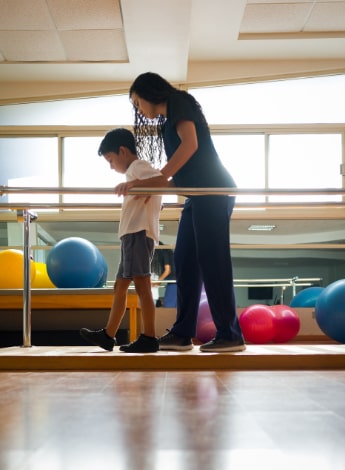
Five facts about… physiotherapy and autism spectrum disorder

APA Paediatric group members Sarah Reedman and Lisa Truscott create five discussion points about physiotherapy in children and young people with autism spectrum disorder (ASD).
1. Movement difficulties are highly prevalent in children with ASD
ASD is defined by deficits in social communication and the presence of restricted and repetitive behaviours, with some motor deficits acknowledged (American Psychiatric Association 2013).
Evidence increasingly demonstrates heterogeneous atypical motor function in many children and adolescents with ASD, including motor delays, deficits, and planning challenges (Hudry et al 2020).
Risk of movement difficulties was identified in 87 per cent of children with ASD, aged 5–15 years (Bhat 2020).
Relative to typically developing peers, this risk in children with ASD is reportedly 22 per cent higher (Bhat 2020).
A West Australian study examining motor difficulties of children with ASD, assessed at diagnosis (between 2.8 to 6 years), found motor difficulties as prevalent (35.4 per cent) as intellectual impairment (37.7 per cent) (Licari et al 2020).
Despite this, only 1.34 per cent of children were recognised with motor difficulties by diagnosticians such as paediatricians (Licari et al 2020).
Research identified that infant motor ability and communication are related within ASD (West 2019).
It is as yet unclear whether movement difficulties exacerbate ASD behaviours, impact on clinical assessment of ASD, and/or impact on effectiveness of interventions (LeBarton & Landa 2019).
Movement difficulties likely impact on a child’s academic and physical performance, social relationships, independence with self-care and community participation, highlighting the need to understand the extent of movement difficulties in children with ASD (Case & Yun 2019).
2. Physical activity is lower in children with ASD and interventions are effective
Children and youth on the autism spectrum are at risk of low levels of physical activity and high levels of sedentary behaviours, putting them at risk of non-communicable diseases associated with inactivity (Cynthia et al 2019).
There are a number of barriers to physical activity participation for individuals on the autism spectrum, including pragmatic communication differences, sensorimotor impairments and lack of accessible and inclusive programs (Cynthia et al 2019).
A large, recent systematic review and meta-analysis of 29 studies including 1009 youth on the autism spectrum, two to 22 years of age, found moderate to large effect sizes of physical activity interventions on muscular strength/endurance, locomotor skills, manipulative skills, skill-related fitness and social functioning of participants (Healy et al 2018).

The majority of these interventions were delivered outside of a clinic in schools and the community (Healy et al 2018).
As a key purpose of physiotherapy is to ‘promote the health and wellbeing of individuals and the general public/society, emphasising the importance of physical activity and exercise and the facilitation of such activities’ (World Physiotherapy 2019), physiotherapists are uniquely qualified and positioned to provide movement and physical activity interventions to children on the autism spectrum.
Based on clinical practice experiences and research evidence, physiotherapists have suggested that incorporation of physiotherapy in routine care of children on the autism spectrum has the potential to improve health and wellbeing through promotion of physical activity and improved motor development (Cynthia et al 2019).
3. Physiotherapists identify movement disorders prior to ASD diagnosis
Research suggests that developmental motor delays during early childhood may also provide a marker for ASD, before more diagnostically specific signs develop (Harris 2017).
A systematic review of 25 studies examining motor function in children with neurodevelopmental disability identified that motor impairments were evident before age two, later diagnosed with ASD (Lim et al 2021).
Physiotherapists who work with children closely observe child development over time, and are therefore well placed to identify movement delays and disorders before children are diagnosed or identified at risk of ASD (Ben-Sasson et al 2018).
Furthermore, physiotherapists trained in knowledge and awareness of ASD more confidently identify ASD and refer for further assessment (Ben-Sasson et al 2018).
An infant’s early gross motor skills provide an important contribution to their developmental wellbeing (Libertus & Hauf 2017).
Early identification of movement difficulties (prior to ASD diagnosis) facilitates access to early specialised interventions and promote better outcomes for children with ASD (Zwaigenbaum et al 2015).
As recently reported, ‘having access to effective intervention during childhood is an important element of the intervention pathway for children on the autism spectrum, providing an opportunity to support early development and promote longer-term quality of life’ (Whitehouse et al 2020).
4. Physiotherapy improves motor outcomes in children with ASD
Physiotherapists treat children at developmental risk (including children with ASD) (Ben-Sasson et al 2018, Lim et al 2021).
A Queensland survey of physiotherapists (prior to funding arrangements such as NDIS enabling physiotherapy intervention for children with ASD) found considerable physiotherapy services provided to children with ASD aged one to 18 years, with a range of movement difficulties identified (Eskelinen et al 2011).
A recent scientific review of non- pharmacological interventions for children with ASD excluded studies focused solely on exercise; however, it included studies of interventions with a positive effect on motor outcomes (Whitehouse et al 2020).
A systematic review of 20 movement interventions from 18 studies was included in the scientific study, including 11 with fundamental movement skills, three with physical activity and two with equine therapy (Case & Yun 2019).
These movement interventions, often prescribed by physiotherapists, were all found to be effective (Whitehouse et al 2020).

Another recent systematic review of 13 studies found that motor-based interventions likely led to an increase in language skills in children with ASD (Odeh et al 2020).
Other effective interventions in the report include naturalistic developmental and behavioural interventions (cueing, prompting, modelling, shaping and reinforcing required movement behaviours, child-led interactions and imitation), parent-mediated interventions and sensory intervention strategies (combined with motor outcomes) (Whitehouse et al 2020).
Physiotherapists use strategies such as these to develop gross and fine motor skills in children with ASD.
5. Physiotherapy can improve sports participation and activity goals
While large randomised studies are lacking, small case series and pilot studies demonstrate that physiotherapy interventions can be successful at promoting sustained participation in physical activities in children with ASD.
A non-randomised study of 40 Australian children aged five to 12, 19 of whom participated in the NAB AFL Auskick All Abilities program (with disability-focused and mainstream inclusive sessions), and 21 in a comparison group which did not participate, has been recently completed.
Children who participated in Auskick demonstrated a significant reduction in parent-reported anxiety and non-significant increase in organised physical activity outside of the program compared to those in the comparison group (Howells et al 2020).
Participating children, their families and Auskick coaches also had access to an online resource of strategies for inclusive practice called AllPlay Footy.
Another community-based exercise program, Fitskills, was evaluated in a small pre-post pilot study of 19 adolescents and young adults with disabilities, including two with ASD.
Youth worked out at a local gym with an able-bodied peer mentor, following a progressive resistance exercise program designed by a physiotherapist or exercise physiologist.
Participants demonstrated increases in muscle strength, walking endurance and improved health-related quality of life (Shields et al 2019).
Finally, participants in a 12-week adapted cycling program increased their self-regulated participation and improved their ability to meet time and distance goals, as highlighted in a small case series (Todd et al 2010).
Dr Sarah Reedman, APAM, is an early-career research fellow at the University of Queensland Child Health Research Centre. Sarah’s research focuses on physical activity promotion and enabling participation in children and young people with disabilities.
Lisa Truscott, APAM, is undertaking a Master of Education and Professional Studies at Queensland’s Griffith University.
Click here for an infographic poster version of this article.
References
American Psychiatric Association. (2013). Diagnostic and Statistical Manual of Mental Disorders Fifth Edition (DSM-5). Washington: DC: American Psychiatric Association.
Ben-Sasson, A., Atun-Einy, O., Yahav-Jonas, G., Lev-On, S., & Gev, T. (2018). Training physical therapists in early ASD screening. Journal of Autism and Developmental Disorders, 48, 3926–3938. doi:10.1007/s10803-018-3668-
Bhat, A. N. (2020). Motor Impairment Increases in Children With Autism Spectrum Disorder as a Function of Social Communication, Cognitive and Functional Impairment, Repetitive Behavior Severity, and Comorbid Diagnoses: A SPARK Study Report. Autism Research. doi:10.1002/aur.2453
Case, L., & Yun, J. (2019). The effect of different intervention approaches on gross motor outcomes of children with autism spectrum disorder: a meta-analysis. Adapted Physical Activity Quarterly, 36(4), 501-526. doi:10.1123/apaq.2018-0174
Cynthia, C., Duck, M., McQuillan, R., Brazill, L., Malik, S., Hartman, L., . . . Jachyra*, P. (2019). Exploring the Role of Physiotherapists in the Care of Children with Autism Spectrum Disorder. Physical & Occupational Therapy in Pediatrics, 39(6), 614-628. doi:10.1080/01942638.2019.1585405
Eskelinen, J., Milne, N., Low Choy, N., Schuhmann, K., Truscott, L., & Steele, M. (2011). Physiotherapists provide considerable services to children with ASD and indicate needs for professional development and clinical guidelines: an observational study. Abstract from APA Physiotherapy Conference 2011, (p. 68). Brisbane. Australia.
Harris, S. R. (2017). Early motor delays as diagnostic clues in autism spectrum disorder. European Journal of Pediatrics, 176(9), 1259-1262. doi:10.1007/s00431-017-2951-7
Healy, S., Nacario, A., Braithwaite, R. E., & Hopper, C. (2018). The effect of physical activity interventions on youth with autism spectrum disorder: A meta-analysis. Autism Research, 11(6), 818-833. doi:https://doi.org/10.1002/aur.1955
Howells, K., Sivaratnam, C., Lindor, E. et al. Can Participation in a Community Organised Football Program Improve Social Behaviour Functioning and Communication in Children with Austism Spectrum Disorder? A Pilot Study. J Autism Dev Disord 50, 3714-3727 (2020).
Hudry, K., Chetcuti, L., & Hocking, D. R. (2020). Motor functioning in developmental psychopathology: A review of autism as an example context. Research in Developmental Disabilities, 105, 1-13. doi:10.1016/j.ridd.2020.103739
LeBarton, E. S., & Landa, R. J. (2019). Infant motor skill predicts later expressive language and autism spectrum disorder diagnosis. Infant Behavioral Development, 54, 37-47. Retrieved from https://doi.org/10.1016/j.infbeh.2018.11.003
Licari, M. K., Alvares, G. A., Varcin, K., Evans, K. L., Cleary, D., Reid, S. L., . . . Whitehouse, A. J. O. (2020). Prevalence of Motor Difficulties in Autism Spectrum Disorder: Analysis of a Population-Based Cohort. Autism Research, 13(2), 298-306. doi:10.1002/aur.2230
Lim, Y. H., Licari, M., Spittle, A. J., Watkins, R. E., Zwicker, J. G., Downs, J., & Finlay-Jones, A. (2021). Early Motor Function of Children With Autism Spectrum Disorder: A Systematic Review. Pediatrics, 147(2), e2020011270. doi:10.1542/peds.2020-011270
Shields, N., Van den Bos, R., Buhlert-Smith, K., Prendergast, L., Taylor, N., (2019) A Commun ity Based exercise program to increase participation in physical activities among youth with disability: a feasibility study, Disability and Rhabilitation, 41:10, 1152-1159
Odeh, C. E., Martell, R., Griffin, S., Johnson, E. R., & Gladfelter, A. L. (2020). Motor-based interventions improve language outcomes in children with autism: A systematic review. Clinical Archives of Communication Disorders,, 5, 1-7. doi:10.21849/cac
Todd,T., Reid, G., & Butler-Kisber, L. (2010). Cycling for Students with ASD: Self-Regulation Promotes Sustained Physical Activity, Adapted Physical Activity Quarterly, 27(3), 226-241.
West, K. L. (2019). Infant motor development in autism spectrum disorders: A synthesis and meta-analysis. Child Development, 90(6), 2053-2070. doi:10.1111/cdev.13086
Whitehouse, A., Varcin, K., Waddington, H., Sulek, R., Bent, C., Ashburner, J., . . . Trembath, D. (2020). Interventions for children on the autism spectrum: A synthesis of research evidence. Brisbane: Autism CRC.
World Health Organisation. (2007). International Classification of Functioning, Disability, and Health: Child & Youth version: ICF-CY. Geneva, Switzerland: World Health Organisation.
World Physiotherapy. (2019). Description of physical therapy: Policy statement. Retrieved from
Zwaigenbaum, L., Bauman, M. L., Choueiri, R., Kasari, C., Carter, A., Granpeesheh, D., . . . Natowicz, M. R. (2015). Early intervention for children with autism spectrum disorder under 3 years of age: Recommendations for practice and research. Pediatrics, 136, S60-S81. doi:10.1542/peds.2014-3667E
© Copyright 2024 by Australian Physiotherapy Association. All rights reserved.





